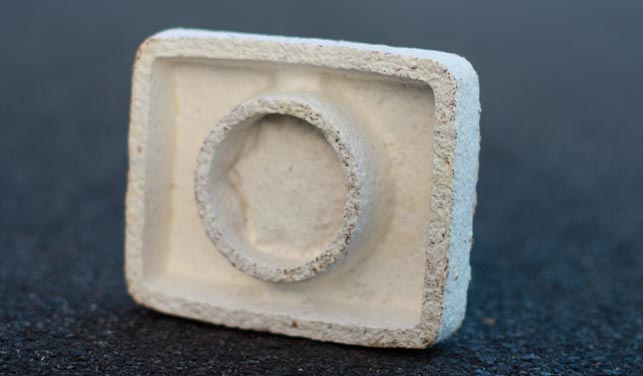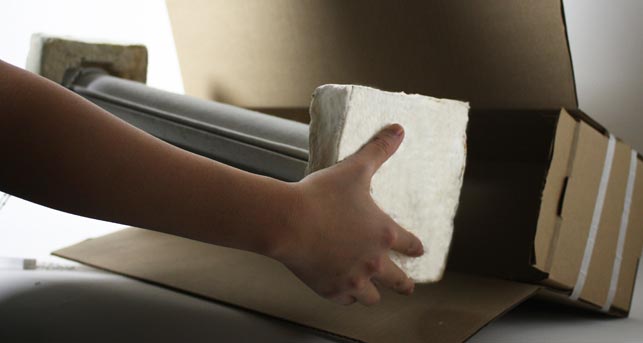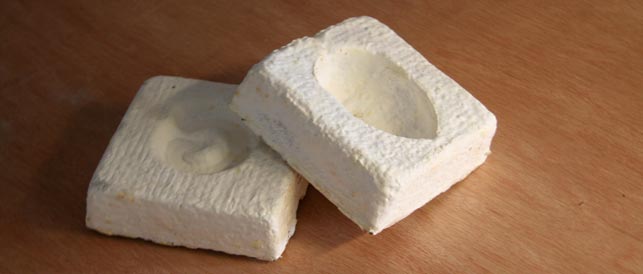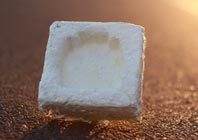Interview with Sam Harrington, Ecovative’s environmental director
Ecovative Design, a bio-materials company located in Green Island, New York, was founded in 2007 by two Rensselaer Polytechnic Institute Mechanical Engineering and Product Design graduates, Eben Bayer and Gavin McIntyre.
Fascinated with the way in which mushrooms grow on wood chips and how the fungal mycelium bonded the chips together, they began thinking of new ways of using mycelium as a resin. In a class at Rensselaer they applied this new process for binding together insulating particles, creating Greensulate. Rather than just decreasing the environmental impact of conventional polystyrene foams, this invention creates a whole new paradigm where composite materials are literally grown.
Having won small grants from the American Society of Mechanical Engineers (ASME) and the National Collegiate Inventors and Innovators Alliance (NCIIA), the pair set up Ecovative once they had graduated. Having created initial samples of the material they went on to win bigger grants from the New York State Energy Research and Development Authority (NYSERDA) and the Environmental Protection Agency (EPA) to further develop the products.
EcoCradle protective packaging was launched in June 2010. The agricultural byproducts used to create the packaging are sourced locally. It’s grown (not manufactured) in an energy efficient production facility powered using hydroelectricity. Following the cradle to cradle principles, once the packaging has served its purpose it can be mulched, composted or thrown away to break down naturally.
EcoCradle’s first commission was for office furniture manufacturer Steelcase who was looking to replace its pretrochemical based foam packaging buffers for its ready to assemble (RTA) office furniture. The formulation created for this project has exceeded Steelcase’s stringent requirements for performance, environmental responsibility and cost.

Ecocradle packaging is biodegradable and home compostable.
D3D: Ecovative make decisions based on life cycle assessments (LCA). Could you explain this process and the software you use to help you?
Sam: We use SimaPro software to conduct our LCA’s. At this point, the LCA is most useful as an internal screening tool when considering the environmental implications of design and engineering decisions. Once our manufacturing system is finalised, we will be conducting a peer reviewed and published LCA, with the goal of getting this data listed in the National Renewable Energy Laboratory’s US Life Cycle Inventory database, and beyond.
D3D: Does this LCA include shipping and disposal of the packaging too?
Sam: Yes, this is a cradle to grave LCA so it considers all steps of the lifecycle of our materials.
D3D: Could you tell me a bit about your manufacturing facilities?
Sam: Yes, our pilot facility in Green Island is powered by an old hydro plant originally built for a now gone Ford radiator plant. Our facility here has offices, biological R&D labs, an engineering machine fabrication shop, and a production facility with a capacity of about 10,000 EcoCradle parts per month. We will be expanding this spring to a facility nearby with five times the floorspace.
D3D: Not only do you have a sustainable business but all your employees try to lead sustainable lives. Apart from cycling to work, how do you do this and is it hard work?
Sam: A lot of us grow some of our own food locally and organically, and otherwise shop at the local farmers market or food co-op. We also now get hot local food delivered for lunch once a week for a company group meal. Living more sustainable lives isn’t a sacrifice, it’s better. For example, biking to work is fun, keeps me in shape, and saves time, since I don’t have to drive to work, drive home, drive to the gym, and sit indoors watching a screen on an exercise bike.

D3D: Do you have any major companies apart from Steelcase that have shown an interest in EcoCradle?
Sam: Yes, we’ve seen an overwhelming amount of interest in EcoCradle. We literally can’t make it fast enough. We will be announcing the launch of EcoCradle packaging with some very exciting electronics customers this spring. Stay tuned!
D3D: Would you say that your packaging performs as well and is as competitively priced as conventional packaging?
Sam: Yes. Depending on the application, we find that we are generally cost and performance competitive with moulded or fabricated EPS, EPP and EPE foams. In some cases, we can also compete with moulded paper pulp or other moulded packaging materials.

EcoCradlepackaging is literally ‘grown’, not manufactured. A growing organism transforms agricultural byproducts like cotton seed hulls and buck wheat hulls into a beautiful protective package
D3D: Any lessons that you have learned during EcoCradle’s development and manufacturing that you’d be willing to share to help others embarking on a sustainable design project?
Sam: Always reconsider your assumptions. This material was originally designed just to be a new form of insulation. We later realised that this wasn’t just a more environmentally responsible insulator, it was a radical new way to GROW a wide range of materials. Today our focus is on packaging as a start to focus our efforts on. Long term though, we see this as an alternative to plastics for everything from packaging to car parts to surfboards. Always ask yourself, what else could this be? What other problems could this solve?
Interview with Sam Harrington, Ecovative’s environmental director
No






